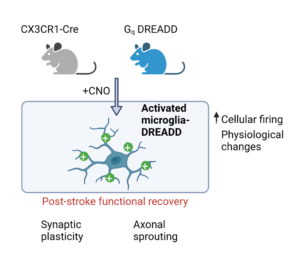Post-stroke recovery remains a clinical and experimental challenge. To improve therapeutic efforts, we need a better understanding of the underlying interaction of the main cellular players.
Under homeostatic conditions, microglia has an important role aiding synaptic neuronal function. Upon its activation, microglia substantially affects spontaneous recovery after stroke, including structural and functional reestablishment of neurovascular networks, axonal remodeling, and regeneration processes.
Here, we will make use of the new available mouse models and cutting-edge technology to investigate the role of the microglia – neuron interaction in ischemic stroke. We hypothesize that activating microglia during the recovery phase of stroke will result in reduced inhibition and improved functional recovery. To verify this hypothesis, we will first analyse microglia at different stages of stroke recovery and focus on pathways that can trigger neuronal responses. Then, we will use our newly developed microglial DREADD mice to alter stroke-induced synaptic plasticity and axonal sprouting. Finally, we will activate microglia and block adenosine through intracerebral nanobody treatment to enhance neuronal recovery for a translational relevance.